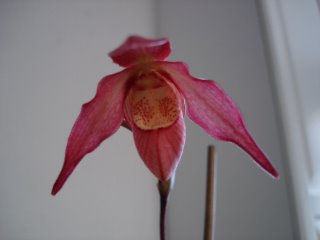A popular mistake with the novice Paph grower is overwatering. Though no doubt Paphs like their water, their roots can easily be rotted through over-accumulation of water in the pot. I once experienced this myself, with my first paph, and I can tell you it is possible to revive your waterlogged paph, provided the case is not too severe, especially since mine is still alive today.
You can tell when a paph has lost most or all of its roots because the plant's leaves will have gone limp if it were in that condition for some time, and the plant will be loose in the pot. As well, the plant will probably not grow much (or cease growing). To revive your plant, try this:
1. Remove the plant from its old pot and mix.
2. Examine the plant; look for any rotten parts on the leaves and roots. Cut off all the rotten roots. If roots are only partially rotten, cut into the live part and dust with cinnamon. It is likely that the base of the plant will have rotted as well. If you have any leaves that are rotten at the base, cut them off, and remove all rotten parts on the rhizome, dusting any wounds with cinnamon. If you have any leaves or a developing growth left after this, whether you have any roots or not, you may be able to revive the plant. Otherwise, discard it and hopefully you have learned your lesson!
3. Next, cut a plastic bottle in half (preferably a small 650mL or similar) and fill the bottom with moist sphagnum moss.
4. Nestle the plant in the moss.
5. Replace the top half of the bottle over the bottom half and leave the cap off for air. This setup keeps the plant's surroundings moist and humid, conditions required for root development.
6. Check the moss periodically to keep it moist, and moisten it when required by taking off the top half of the bottle and replacing it afterwards.
After a few weeks, your plant should begin to develop new roots; once the roots are over an inch in length and there are at least two of them, you can repot the plant in as small a pot as possible, in fine fir bark, and resume usual care. Your plant may not bloom for a couple of seasons.



 This Paphiopedilum complex-type hybrid, Paph (Yerba Buena x Golden Days) x spicerianum, is the latest addition to my collection. I love paph complex-types for their exotic flowers and compact growth habit. They are easily grown on an east windowsill alongside Phalaenopsis, Miltoniopsis, other Paphs, and others.
This Paphiopedilum complex-type hybrid, Paph (Yerba Buena x Golden Days) x spicerianum, is the latest addition to my collection. I love paph complex-types for their exotic flowers and compact growth habit. They are easily grown on an east windowsill alongside Phalaenopsis, Miltoniopsis, other Paphs, and others.


